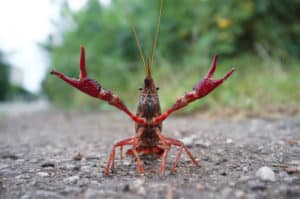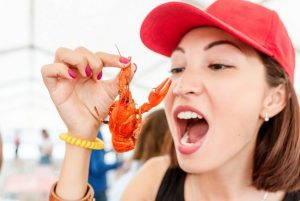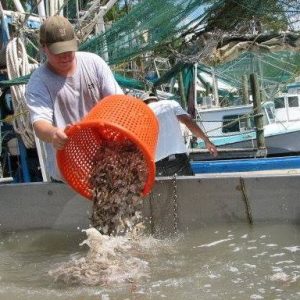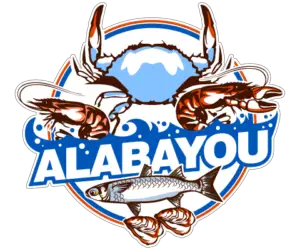I once hosted a crawfish boil and a friend of mine from Idaho thought crawfish were bugs and was horrified when he found out people were eating them.
He couldn’t believe he had been missing out on such a delicacy and exclaimed, “I thought you guys were eating bugs this whole time?! I’m shell-shocked!”
This raises the question “Are crawfish bugs?”. No Crawfish are not Bugs. Crawfish (also known as crayfish or crawdads) are freshwater crustaceans. They are related to lobsters and are more closely related to shrimp than to insects. Crawfish have a hard exoskeleton, two large claws, and several pairs of legs, which are characteristics that are not found in insects.
Misidentification between insects and crustaceans is not uncommon. When it comes to crawfish, they are often mistaken as bugs due to their appearance and behavior.
This post aims to clarify the confusion and shed light on what crawfish truly are.

Why are Crawfish called Mudbugs
What are Crawfish?
Crawfish, also known as crayfish or crawdads, are freshwater crustaceans that belong to the order Decapoda.
They are closely related to lobsters and are more closely related to shrimp than to insects.
They can be found in freshwater habitats like streams, rivers, and lakes and are a common delicacy in Cajun and Creole cuisine.
Crawfish is considered a seafood and people from all over the world enjoy this delicious crustacean. Check out our article on why carwfish is a seafood, to impress your friends with all your crawfish knowledge.
Appearance and Characteristics:
Crawfish have a hard exoskeleton that protects their bodies and provides support for their legs and claws. They have two large claws that they use for defense and foraging for food.

They also have several pairs of legs that are used for walking and swimming. Unlike insects, which have six legs, crawfish have 10 legs in total.
Habitat and Behavior:
Crawfish live in freshwater habitats and burrow in the mud or build homes in the water. They are nocturnal creatures that are most active at night.

During the day, they hide in their burrows or homes to avoid predators. They are omnivores and feed on plants, insects, and small fish.
Misconceptions:
Despite the clear differences between crawfish and insects, many people still believe that they are bugs. This could be due to the way they move and the fact that they live in and around water, which is a common habitat for insects.
However, the hard exoskeleton and multiple legs of crawfish set them apart from insects and make it clear that they are not bugs.
Why are Crawfish Called Mud Bugs?
Crawfish are sometimes referred to as “mudbugs” because they live in the mud of freshwater streams, rivers, and swamps.
The term “mudbug” is a colloquial term used primarily in the Southern United States, particularly in Louisiana where crawfish are a popular cuisine item.
The term refers to the creature’s habitat and its association with mud, and has been adopted as a nickname for the crawfish in this region.

Why Do People Eat Crawfish?
People eat crawfish because they are considered a delicacy in many cultures, particularly in the Southern United States and in some parts of Europe.
Crawfish have a delicate, sweet flavor that is often described as a cross between shrimp and lobster, and they are a popular ingredient in a variety of dishes, such as gumbo, jambalaya, and étouffée.
In addition to their flavor, crawfish are also valued for their nutritional benefits. They are low in fat and calories and are a good source of protein, vitamins, and minerals, such as iron, calcium, and zinc.
In Louisiana and other parts of the Southern United States, eating crawfish has also become a cultural tradition, often enjoyed in social settings with friends and family.

Crawfish boils are a popular way to prepare and consume the seafood, with the crawfish served in a spicy broth along with other ingredients like potatoes and corn on the cob.
Conclusion
In conclusion, crawfish are not bugs but are instead freshwater crustaceans. They have a hard exoskeleton, two large claws, and several pairs of legs that make them different from insects.
Understanding the distinction between insects and crustaceans can help prevent future misidentifications and appreciate these creatures for what they truly are.
“Keeping Tradition”
At Alabayou, we believe that preserving the traditions and heritage of commercial fishing families and communities is of utmost importance.
Commercial fishing is more than just a job; it is a way of life that has been passed down from generation to generation for centuries.
However, with real estate development and over regulations threatening coastal towns and communities across the country, these traditions are at risk of being lost forever.
That’s why Alabayou was created, to help preserve and promote the rich history and cultural significance of commercial fishing.
Our mission is to bring together commercial fishing families, communities, and organizations to share their stories, experiences, and knowledge with others.

Whether you are a commercial fisherman, a passionate seafood enthusiast, or simply someone who appreciates the beauty and importance of our coastal heritage, Alabayou is the place for you.
We offer a variety of resources and information to help support and sustain the commercial fishing industry, including industry news, historical articles, and community events.
At Alabayou, we understand that the commercial fishing industry is facing many challenges, but we believe that by working together and sharing our passion and knowledge, we can help ensure that these traditions and way of life continue for generations to come.
Join us in our mission to preserve and celebrate the commercial fishing heritage of our country. Help support Alabayou today!
